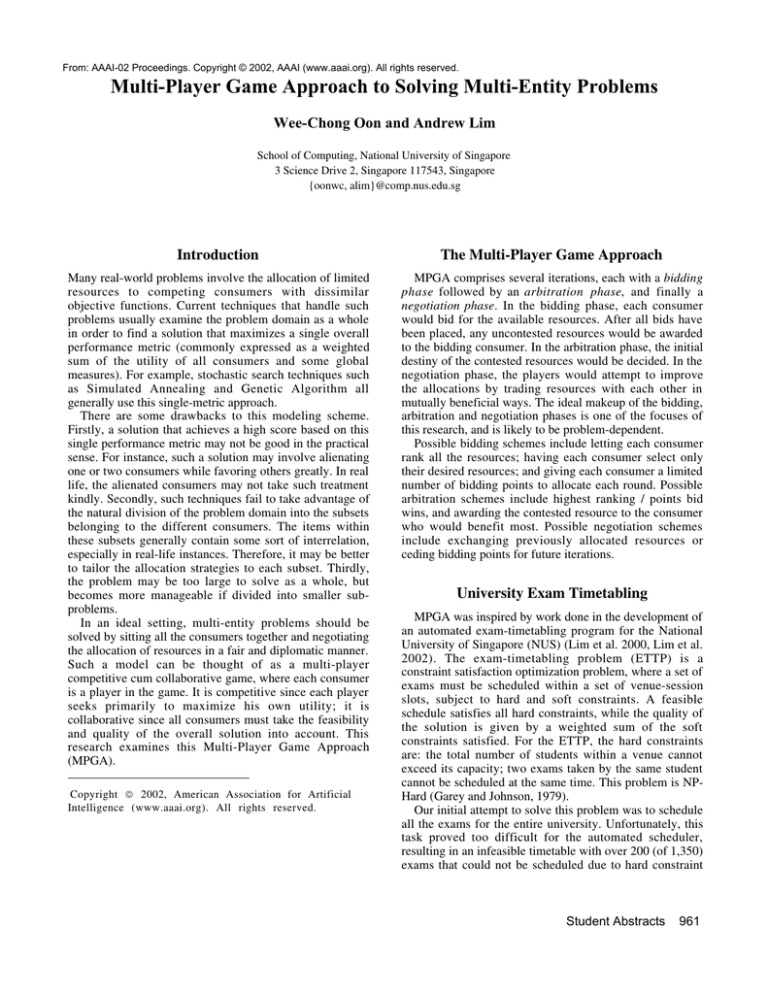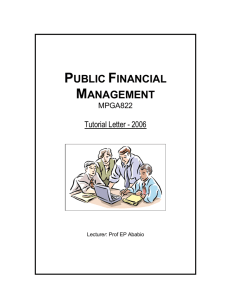
From: AAAI-02 Proceedings. Copyright © 2002, AAAI (www.aaai.org). All rights reserved.
Multi-Player Game Approach to Solving Multi-Entity Problems
Wee-Chong Oon and Andrew Lim
School of Computing, National University of Singapore
3 Science Drive 2, Singapore 117543, Singapore
{oonwc, alim}@comp.nus.edu.sg
Introduction
The Multi-Player Game Approach
Many real-world problems involve the allocation of limited
resources to competing consumers with dissimilar
objective functions. Current techniques that handle such
problems usually examine the problem domain as a whole
in order to find a solution that maximizes a single overall
performance metric (commonly expressed as a weighted
sum of the utility of all consumers and some global
measures). For example, stochastic search techniques such
as Simulated Annealing and Genetic Algorithm all
generally use this single-metric approach.
There are some drawbacks to this modeling scheme.
Firstly, a solution that achieves a high score based on this
single performance metric may not be good in the practical
sense. For instance, such a solution may involve alienating
one or two consumers while favoring others greatly. In real
life, the alienated consumers may not take such treatment
kindly. Secondly, such techniques fail to take advantage of
the natural division of the problem domain into the subsets
belonging to the different consumers. The items within
these subsets generally contain some sort of interrelation,
especially in real-life instances. Therefore, it may be better
to tailor the allocation strategies to each subset. Thirdly,
the problem may be too large to solve as a whole, but
becomes more manageable if divided into smaller subproblems.
In an ideal setting, multi-entity problems should be
solved by sitting all the consumers together and negotiating
the allocation of resources in a fair and diplomatic manner.
Such a model can be thought of as a multi-player
competitive cum collaborative game, where each consumer
is a player in the game. It is competitive since each player
seeks primarily to maximize his own utility; it is
collaborative since all consumers must take the feasibility
and quality of the overall solution into account. This
research examines this Multi-Player Game Approach
(MPGA).
MPGA comprises several iterations, each with a bidding
phase followed by an arbitration phase, and finally a
negotiation phase. In the bidding phase, each consumer
would bid for the available resources. After all bids have
been placed, any uncontested resources would be awarded
to the bidding consumer. In the arbitration phase, the initial
destiny of the contested resources would be decided. In the
negotiation phase, the players would attempt to improve
the allocations by trading resources with each other in
mutually beneficial ways. The ideal makeup of the bidding,
arbitration and negotiation phases is one of the focuses of
this research, and is likely to be problem-dependent.
Possible bidding schemes include letting each consumer
rank all the resources; having each consumer select only
their desired resources; and giving each consumer a limited
number of bidding points to allocate each round. Possible
arbitration schemes include highest ranking / points bid
wins, and awarding the contested resource to the consumer
who would benefit most. Possible negotiation schemes
include exchanging previously allocated resources or
ceding bidding points for future iterations.
Copyright 2002, American Association for Artificial
Intelligence (www.aaai.org). All rights reserved.
University Exam Timetabling
MPGA was inspired by work done in the development of
an automated exam-timetabling program for the National
University of Singapore (NUS) (Lim et al. 2000, Lim et al.
2002). The exam-timetabling problem (ETTP) is a
constraint satisfaction optimization problem, where a set of
exams must be scheduled within a set of venue-session
slots, subject to hard and soft constraints. A feasible
schedule satisfies all hard constraints, while the quality of
the solution is given by a weighted sum of the soft
constraints satisfied. For the ETTP, the hard constraints
are: the total number of students within a venue cannot
exceed its capacity; two exams taken by the same student
cannot be scheduled at the same time. This problem is NPHard (Garey and Johnson, 1979).
Our initial attempt to solve this problem was to schedule
all the exams for the entire university. Unfortunately, this
task proved too difficult for the automated scheduler,
resulting in an infeasible timetable with over 200 (of 1,350)
exams that could not be scheduled due to hard constraint
Student Abstracts
961
violations. There was also great resistance from the
individual faculty timetable administrators, who disliked
the lack of personal control of a centrally scheduled
timetable. As a result, a partially distributed strategy was
adopted, where each faculty was given a copy of the
scheduling program and allocated a partition of the time
slots. The faculties then scheduled their own exams within
their allotted partitions, and the central authority would
merge these timetables into a collated whole and resolve
the conflicts. Paradoxically, even though the same
scheduling engine was used, this partition-merge approach
achieved a solution where only 12 exams were left
unscheduled (Lim et al. 2002).
MPGA is the logical extension of this partition-merge
approach. The problem with the allocation of slot partitions
to the different faculties is that artificial constraints are
added. Using MPGA, each faculty is a player in a game,
and all faculties are given access to all the available slots.
One possible implementation of MPGA is as follows. In
the bidding phase, each faculty bids for the slots by placing
their exams into ideal slots. In the arbitration phase, the
central authority would first attempt to merge the ideal
schedules together as far as possible. Then, each contested
slot is allocated to the exam that is “obviously most
suitable” as determined by some measure. Ambiguous
contested slots are not allocated. In the negotiation phase,
the faculties attempt to improve their allocation by
exchanging slots with each other in mutually beneficial
trades. The next iteration begins with each faculty
attempting to place their exams in the remaining slots if
possible. If not, the unscheduleable exams may bid to be in
a filled slot, and may replace the existing exam if the
former is deemed “obviously most suitable”. This is
repeated until no more improvements occur.
Research Issues
The division of a problem into separate interrelated
processes is similar to the concept of Multi-Agent Systems
(MAS) (Lesser 1995, Sycara 1998), even though MPGA
can be implemented centrally. Common MAS issues like
the prevention of looping behavior, control of information
flow and the increased complexity of implementation
(when compared to single-agent systems) must also be
addressed in MPGA.
Since MPGA is a natural approach to solving multientity optimization, it presents some distinct advantages.
MPGA avoids using a single performance metric, instead
relying on a logical process to produce the result. This idea
is also seen in the area of market-based control (Clearwater
1996). Each player in the game can use different
approaches, which may be guided by ideas of achieving
Nash equilibrium (Osborne and Rubinstein 1994), but more
likely in the form of simple rule-based heuristics.
Furthermore, a log of the entire process can be kept as a
step-by-step report of the bidding and arbitration process,
which can be used to convince the human consumers that
the final solution is fair and just. In real-life problems, this
political aspect is an important factor.
962
Student Abstracts
In essence, MPGA simulates a community of experts,
each attempting to achieve their best possible solution.
Ideally, the heuristics used for the bidding and negotiation
phases can be obtained from actual human experts.
Unfortunately, these experts are seldom computer science
professionals, and translating their strategies into
algorithmic form may be problematic. This is a common
problem in the domain of expert systems (Jackson 1999).
Conclusion
MPGA models complex multi-entity problems as a
multi-player game, where each entity in the problem is a
player in the game. A fair and just set of rules is imposed
for the game, which is played in several iterations of
bidding, arbitration and negotiation phases, and each player
can employ a different customized strategy. Not only does
MPGA have the advantage of being instinctive and
understandable, such that actual human consumers can be
more easily convinced of the fairness of the final solution,
experiments on the university examination timetabling
problem suggests that MPGA may produce better solutions
than traditional centralized methods.
References
Clearwater, S. ed. 1996, Market-Based Control: A
Paradigm for Distributed Resource Allocation, World
Scientific.
Garey, M. R. and Johnson, D. S. 1979. Computers and
Intractability: A Guide to the Theory of NP-Completeness.
Jackson, P. 1999. Introduction to Expert Systems, 3rd
Edition, Harlow England: Addison-Wesley Longman.
Lesser, V. R. 1995. Multiagent Systems: An Emerging
Subdiscipline of AI, ACM Computing Surveys 27(3), vol.
27, no. 3: 340-342.
Lim, A.; Ang, J. C.; Ho, W. K.; and Oon, W. C. 2000. A
Campus-Wide University Examination Timetabling
Application, in Innovative Applications in Artificial
Intelligence (AAAI/IAAI) 2000: 1020-1025.
Lim, A.; Ang, J. C.; Ho, W. K.; and Oon, W. C.
UTTSExam: A Campus-Wide University ExamTimetabling System, accepted to Innovative Applications
in Artificial Intelligence (AAAI/IAAI) 2002.
Osborne, M. J. and Rubinstein, A. 1994, A Course in Game
Theory, Cambridge Mass., MIT Press.
Sycara, K. 1998. Multiagent Systems, AI Magazine 19(2):
79-92.






